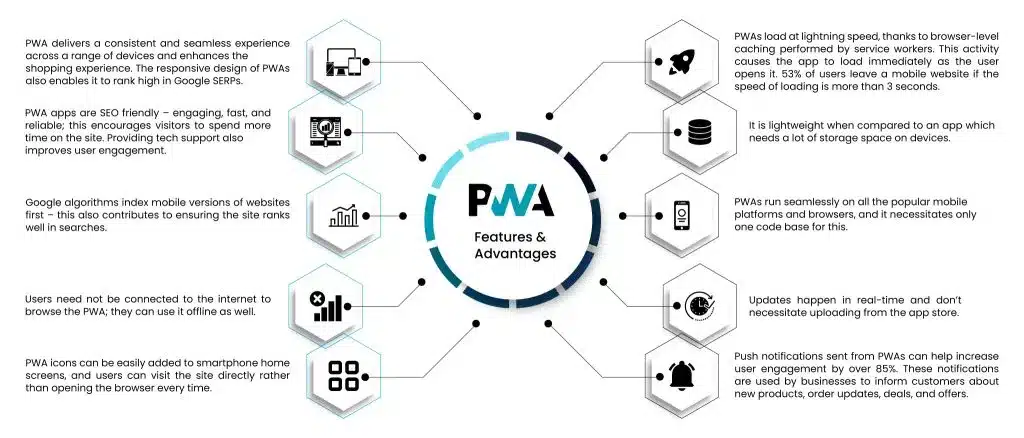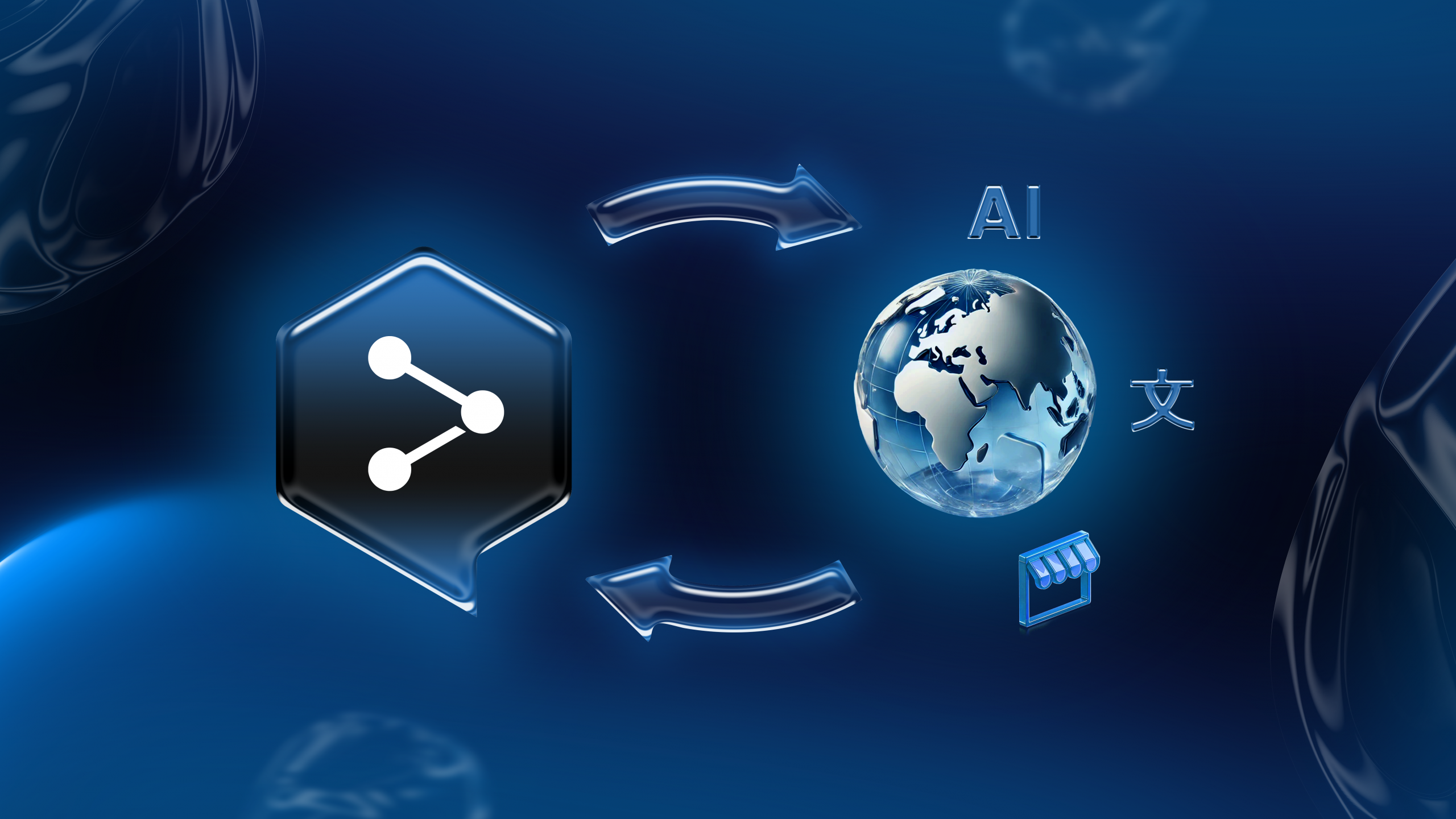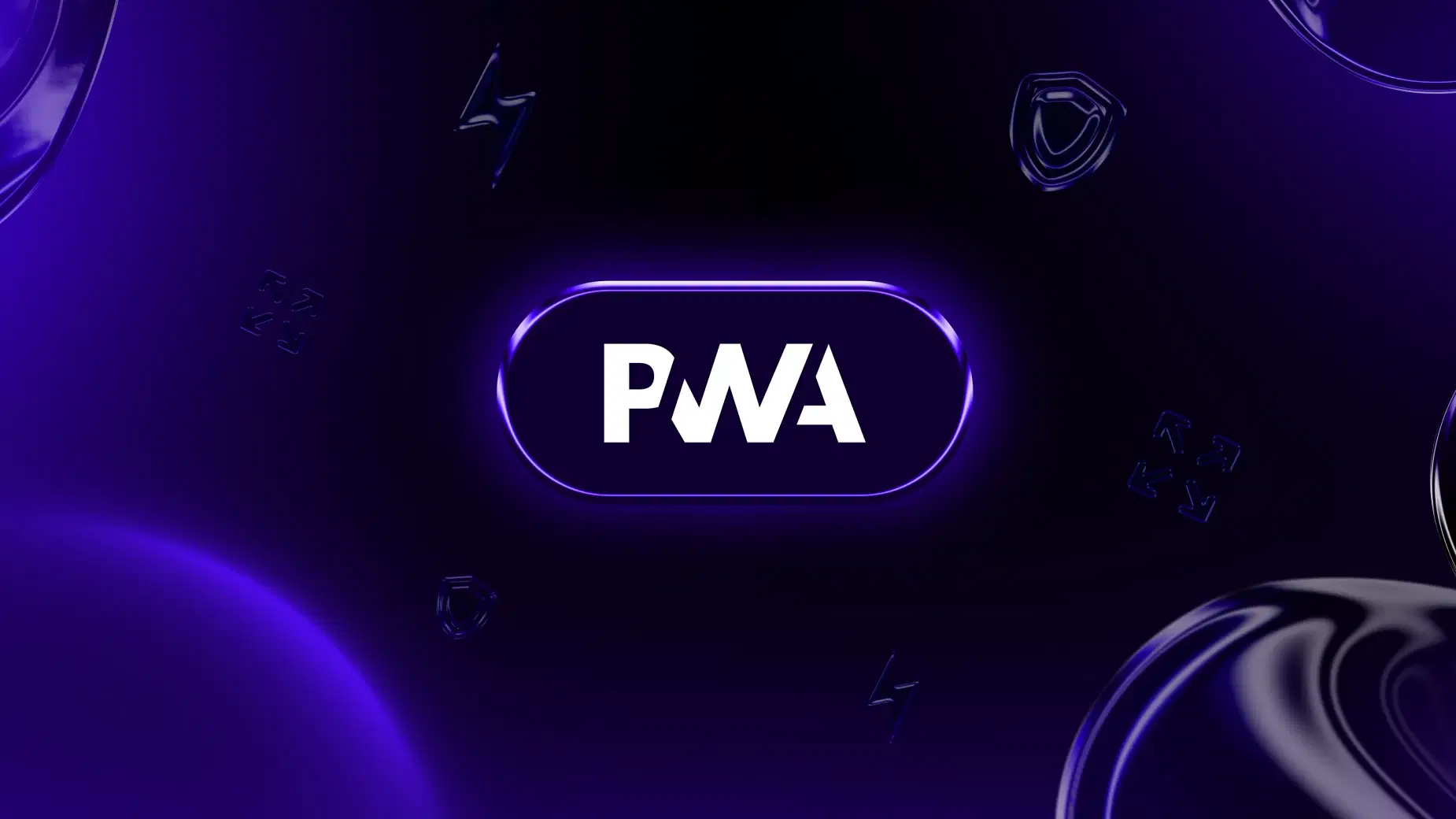It is said that nothing is certain in life except change. And the world of IT is a standing testimonial to that, what with technologies becoming obsolete by the time everyone gets comfortable with them! Consumers are getting more and more tech savvy and discerning, and today demand not just convenience but excitement. Many individuals use different devices – smartphones, tablets, laptops and desktops, and want comparable experiences no matter what they use to access a site.
With over 5.3 billion unique mobile users all over the world today, it was imperative that businesses make it easy for consumers to shop via their hand-held devices. So, they made apps which made it convenient for shoppers to purchase on the go – a huge improvement over mobile sites.
With time, people were no longer satisfied with just mobile apps. Apps meant downloading from the store, sacrificing space on the phone, and waiting for it to load – and often, messy updates. And now Progressive Web Apps have grabbed the spotlight to become an alternative to traditional, space-consuming apps.
In this article, you will get a comprehensive view of WHAT, WHY, and HOW PWA in 2023 works.
What is PWA?
A progressive web app is a cross between a native app and a mobile web page that can be loaded and run in a mobile browser and makes the user feel like they are using an app. A PWA can do almost everything a native app can, like access your microphone and camera, operate offline, and so on. Unlike an app, it loads rapidly, doesn’t eat into the storage space of devices, delivers a much better browsing experience, and users can access the app with just one click.
A little History
Though the legendary Steve Jobs envisioned this idea way back in 2007 when he launched the iPhone, he was unable to build on his initial idea. It was only in 2015 that two employees from Google – a developer and a designer – coined this term; they made their own additions to Jobs’ idea of eliminating native apps
Some Interesting Mobile Commerce Statistics
Back in 2018 itself, mobile users spent 18 billion hours browsing shopping-related applications. In fact, over 50% of global web traffic today, is from mobile applications. The share of mobile commerce is growing at a steady pace and is expected to make up 44.2% of E-commerce sales, amounting to over $728 billion in the US alone.
According to the various industry experts, here are some predictions:
- Mordor Intelligence predicts a 29.5% growth in the mobile payments market
- Business Wire expects global M-commerce sales to account for over 50% of all eCommerce sales.
- There has been a revenue growth of 450% (as of 2020) in mobile commerce compared to 2015
- Statista says they expect global M-Commerce sales to touch 4 trillion USD by 2022
- WhaTech estimates a growth of 56.5% for the global mobile coupon industry by 2025.
- According to Synchrony, 70% of consumers have downloaded at least one shopping application.
- Emarketer stated that nearly 80 million people will be using mobile payments in the US by 2023.
- Over 75% of shoppers use their mobile phones to compare prices when shopping in stores.
The total time spent on the internet through mobile devices has increased globally:
Brands like Debenhams, Lancôme AliExpress, Flipkart, Jumia have all developed PWAs. These brands all reported improvements in several sectors, with Lancôme specifically reporting:
- 17% increase in conversions
- 15% reduction in bounce rate
- 51% rise in mobile sessions
The PWAs offered a seamless experience, and loaded quickly without eating up storage space; hence the change.
How does a PWA Work?
Single-Page Website
PWAs are mostly single-page sites that dynamically rewrite the page to interact with the user instead of requesting a full-page load when the user clicks on the link. The JavaScript code controls the page the user is on to render it as if it’s the new page – this is the native app ‘feel’.
Web App Manifest
This is a JSON file that signals the browser regarding the expected app behaviour when it’s installed on the user device. It contains generic app info but is essential to make the PWA appear and feel like a native app. App name, start_url it must commence at on app launch, icons to be used, etc. is the information the file usually contains. On fulfilling specific conditions, most browsers will auto-recommend the app installation to users. Chrome mandates this manifest for displaying the prompt ‘Add to Home Screen’.
Service-Workers
We’ve read about the amazing features and benefits – now let’s see what drives these features. Service Workers – frontend JavaScript files – are an important of PWAs that exist between the browser and server. They add a background functionality layer to imitate the features of an app. The service workers enable indirect interaction between users and servers unlike conventional websites where it is direct.
Browser Compatibility
PWAs require browser support for push notifications, save to home screen, as well as for service workers. Even when support doesn’t exist, PWAs can still function in all browses – though some features may not work. Chrome is one browser that likes PWAs, and displays an Install button to indicate that a PWA can be installed. Once the user clicks on it, a dialog box is displayed which helps the user to install it.
If you have any further questions, check out our Video Tutorial on PWA
Features and Advantages of PWAs
- PWAs load at lightning speed, thanks to browser-level caching performed by service workers. This activity causes the app to load immediately as the user opens it. 53% of users leave a mobile website if the speed of loading is more than 3 seconds.
- It is lightweight when compared to an app which needs a lot of storage space on devices.
- PWAs run seamlessly on all the popular mobile platforms and browsers, and it necessitates only one code base for this.
- Updates happen in real-time and don’t necessitate uploading from the app store.
- PWA delivers a consistent and seamless experience across a range of devices and enhances the shopping experience.
- The responsive design of the Progressive web app also enables it to rank high in Google SERPs.

- PWA apps are SEO friendly – engaging, fast, and reliable; this encourages visitors to spend more time on the site. Providing tech support also improves user engagement.
- Google algorithms index mobile versions of websites first – this also contributes to ensuring the site ranks well in searches.
- Users need not be connected to the internet to browse the PWA; they can use it offline as well.
- PWA icons can be easily added to smartphone home screens, and users can visit the site directly rather than opening the browser every time.
- Push notifications sent from PWAs can help increase user engagement by over 85%. These notifications are used by businesses to inform customers about new products, order updates, deals, and offers.
How do progressive web apps benefit e-commerce platforms?
PWA is transforming user engagement. Here is how this game changing technology is going to drive user interaction and conversion rates.
Performance
Studies show that 53% of mobile users leave a page if it doesn’t load within 3 seconds. The page load speed is a critical factor that can make the difference between success and failure. PWAs load nearly 300% faster, providing users with an almost instant loading experience.
One key aspect of creating a successful PWA is optimizing its performance through codes and flexible caching mechanisms. With this, it serves a light skeleton document with inlined resources and prioritizes the first meaningful paint and helps load the first page super quickly. Also, by integrating Performance Commerce into your PWA, you can ensure that your users have a fast and seamless experience, even on slow networks.
Accessibility
PWAs are very helpful for businesses operating in developing markets. With their lightning-fast load speeds and consistent accessibility features, they can seamlessly cater to the requirements of a diverse audience. In addition, they offer support features like screen readers, keyboard navigation, and high contrast modes, making it easier for everyone to access and enjoy the content.
User Experience (UX)
Engagement on native apps is a lot higher than on mobile sites. However, PWAs can change this, as they run like native apps on any browser, providing fast loading pages, seamless navigation and smooth animations. Also, they can effortlessly adapt to various screen sizes and resolutions, increasing its mobile responsiveness, one of the most sought-after features by users.
Discoverability
PWAs are highly discoverable as they can be directly accessed through web browsers. Users need not visit the app store to search and find the right application matching their convenience. This increased discoverability can lead to higher conversion rates, especially for businesses targeting a wider customer base.
Increased number of users
People tend to download the apps of only big brands, as apps eat up storage space on phones. But PWAs don’t need to be downloaded, saving space on devices. They can simply be added to the home screen, and the user can browse at any time.
Higher rates of conversion
Mobile web conversions are lower than on apps; however, the seamless native app experience, along with speed, tech support and cross-platform compatibility delivered by PWAs, help to boost conversions. More users spend more time on the PWAs – thereby boosting the chances of them purchasing your products.
PWA can provide numerous benefits for eCommerce websites, including increased engagement, faster loading times, and improved user experience. In fact, some of the biggest brands in eCommerce have already implemented PWAs on their Magento platforms, resulting in significant improvements in performance and conversion rates. For more information on how PWA for Magento can enhance your brand’s performance, check out this article by Codilar.
Why should businesses implement PWA?
Progressive web application development offer a solution to software distribution issues. When users are on a computer, they are more likely to open a website rather than the app installed on the computer; however, the same user is more likely to prefer an app on their phone rather than going to the browser and opening a site.
Let’s take the example of shopping for something on Amazon. The customer will open the app on their phone but is more likely to open the website rather than the web app on their computer. This holds true for all businesses that have efficient native apps – as they load rapidly, send push notifications, use sensors, and sync data.
Mobile web engagement rate is much lower than that of native apps; it’s less than 20% for web while apps see over 80% engagement. Apps provide a rich, fulfilling experience that the web cannot.
Mobile web has a huge reach
An average Android user visits about 100 sites each month, using Chrome to access them – and there are a billion monthly users for mobile Chrome. A negligible number of apps are downloaded in the US each month, yet mobile commerce accounts for a major chunk of E-commerce sales.
Mobile users spend over 85% of mobile time on native apps – but those apps belong to a handful of established and reputed businesses.
In a nutshell – mobile commerce is increasing, but shopping apps are either not being downloaded, or are installed and uninstalled in a short time. This means people are only purchasing from the major apps like Amazon, and then via the web.
So, how you can get people to use the app for your online store?
PWA is the answer!
How PWA’s disrupt the play store and App Store?
With the advent of PWAs, traditional app distribution channels such as Google play store and App Store are witnessing a significant impact. Here’s how PWAs are disrupting these stores:
No App Store Dependence
Unlike native mobile apps, PWAs can be accessed directly through a web browser. Users can even add the PWA to their home screen with a single tap, eliminating the need for app store visits and wasting unnecessary storage space on your device. It also gets automatically updated, freeing users from the hassle of manual updates via the app store.
Cross-Platform Compatibility
Unlike native apps, which are limited to specific operating systems, PWAs can run on any device with a modern web browser. Because of this feature, developers can be saved from the trouble of creating separate versions of their apps for different platforms. This frictionless compatibility enhances user convenience and encourages higher adoption rates.
Cost-Effective
When compared to native apps, PWAs are lightweight and have cached assets. As a result, PWAs are exceptionally efficient in terms of data consumption and storage space usage. This advantage serves as a cost-effective solution for users who have limited data plans or devices with limited storage space.
Also, PWA enables developers to streamline app maintenance by leveraging existing web development skills and infrastructure. They can utilize their web development expertise to update and enhance the app, eliminating the need for creating separate layouts and designs for separate devices. Thus, reducing development and maintenance costs.
No Updates Required
Native apps always need periodic updates to fix bugs and add new features. It requires users to open the app store to download the new updates. Whereas, PWAs get automatically updated in the background, ensuring users always have access to the latest version with up-to-date features. Making PWAs more secure and less prone to bugs.
Independent Control and Flexibility
Unlike native apps, which are subject to the rules and regulations imposed by app stores, PWAs provide developers with greater control and flexibility. With PWAs, developers have the freedom to distribute and update their apps without the need to go through lengthy app store approval processes. This independence empowers developers to release updates and bug fixes more efficiently, ensuring a seamless user experience.
Additionally, PWAs allow developers to bypass app store payment mechanisms and commissions, offering alternative monetization strategies. Developers can choose to implement their own payment systems or explore other revenue models without being restricted by app store policies.
Offline Functionality
In general, apps downloaded from app stores need internet connectivity to provide users with an uninterrupted browsing experience. Unfortunately, in cases of poor connectivity, these apps often display error messages. However, PWA resolves this issue by offering offline support enabling users to stay engaged even in the absence of a stable internet connection.
Platforms That Help build Magento PWA
As the Magento store shows an upward trend with the boom in eCommerce and Adobe acquiring Magento in 2018, most of the retail brands are migrating to Magento. According to eCommerce migration experts Cart2Cart, 9% of online retailers migrated their website to Magento in 2019. Here you can have a quick overview of platforms that help build Magento PWA.
Using premade themes
This is the least preferred as it cannot deliver the full functionality and may have bugs. It involves using coding tools and pre-designed web pages to convert a site into a PWA. However, some businesses may only want to use a few specific Magento PWA functionalities, and this is apt for them.
Using extensions and add-ons
You can first install a Magento theme and use extensions that allow the configuration of navigation,search, checkout etc. to make it more intuitive and responsive without custom coding.
Building from Scratch
JavaScript libraries like Angular.js. Vue.js, and React.js help developers build custom PWAs with unique capabilities. These libraries are flexible and lightweight and are very popular for E-Commerce apps. Of course, this necessitates technical expertise and experience in coding. This is the best method for businesses who want to deliver a personalized, rich, and engaging browsing and shopping experience for their users.
Magento PWA Studio
Magento PWA Studio is a toolkit that enables developers to build PWAs without hassles. It is a Magento product and enables PWA for the E-Commerce platform. It comprises ready-to-use components and front-end architecture; it minimizes the possibility of error in the initial stages, so that the work in the later stages is not impacted. Its biggest benefit is that its polylith structure allows you to extract and use parts of the code rather than the entire package. PWA Studio includes an app builder that is pre-configured, and service workers, as well as several elements that you can use with or without customization to suit your requirements.
Get access to the entire webinar replay here on ‘Getting Hands-on with Magento PWA Studio’ with Github access.
Latest PWA Trends and Best Practices
Studies show that mobile app users, on average, spend close to 202 minutes a month on shopping; compare that to about 11 minutes a month for website users. In-app purchases are steadily increasing, leading to a steep rise in in-app advertising. PWAs in 2023 are taking the mobile app development industry by storm.
Multiple reports and studies suggest that PWAs will rule the roost in 2022 and beyond, for a few years to come at least. They are platform agnostic, and installation is a breeze; what more could anyone want?
With Microsoft and Google taking an avid interest in PWAs, the future certainly looks bright. We can expect to see sophisticated apps packed with features soon making their appearance in the app stores.
Modern PWA solution trends confirm that these apps have the power to benefit businesses from mom-and-pop stores to multinational enterprises.
Entrepreneurs and managers must evaluate their objectives and requirements before jumping on the bandwagon. Here are some things to remember:
- Undoubtedly PWAs are game changers capable of delivering impact instantly. Remember, however, to ensure that the features should heighten user experience, rather than be a distraction.
- The purpose of PWAs is to help users perform the desired actions easily and quickly; ergo, ensure you remove all unnecessary content, only highlighting your USP, and the Call to Action.
- Make it extra convenient for users to purchase your products by simplifying checkout, including automated sign-in, one-tap signup, safe and integrated payment, and automating form filling. When lengthy and convoluted, these often cause cart abandonment and customer dissatisfaction.
- If users have to wait for an action to complete, make it engaging using animations, skeleton screens, etc. Not only will these things entertain users, but they will also give them time for self-orientation.
- Ensure you develop a striking and meaningful icon for the home screen install feature. It’s a powerful tool and can add great value to your organization.
- Use consistent, simple fonts to minimize distractions and provide a seamless experience.
- Don’t forget to provide the important features for the offline browsing mode, and include options for caching.
Do you want Codilar to set up PWA for your business? Contact us now!









